The University of Michigan Ground Services has divided the campus into seven separate zones. Campus has three levels of priority that dictate how often the lawns are fertilized. Priority one receives four applications per year, priority two receives two applications per year, and priority three does not receive any fertilizer.
Grounds Services uses slow-release fertilizer on campus which releases the nutrients gradually over time. This allows Grounds Services to fertilize less often and the nutrients are put into the ground more steadily. An application is one pound of nitrogen per 1000 square feet of granular slow-release fertilizer.
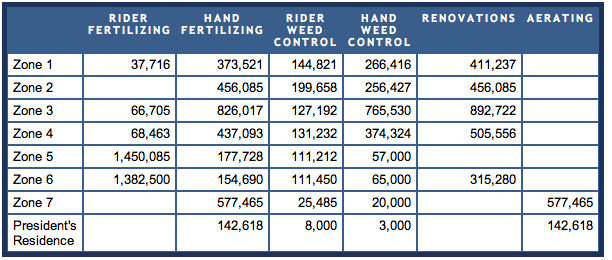
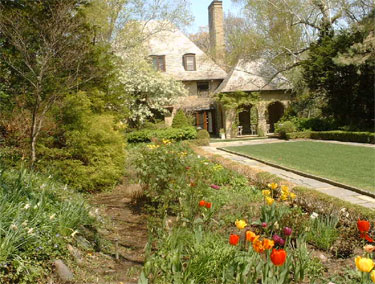 The Inglis House and President's residence are taken care of by Denise Schroeder.
The Inglis House and President's residence are taken care of by Denise Schroeder.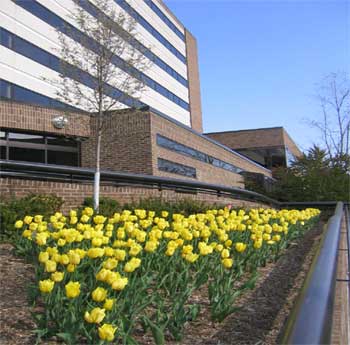
ZONE ONE
Regent's Plaza, Law Quad, Business School block,
East Quad, South Quad, West Quad, Betsy Barbour, Helen Newberry, and west of State Street
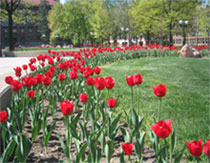 ZONE TWO
ZONE TWOThe Diag on central campus and the areas around Mason Hall, Kraus Nat Sci, East Hall, Randall Lab, Dennison, CC Little, Shapiro Library, Hatcher Library, Dana, and Chemistry
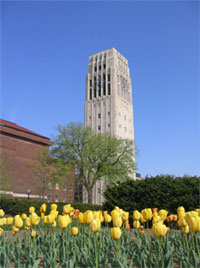 ZONE THREE
ZONE THREEIngalls Mall, Rackham and Dental School blocks,
CCRB, Lane Hall, School of Public Health I & II, Detroit Observatory, Mary Markley, Stockwell Hall, Mosher Jordan Hall, Couzens Hall, Alice Lloyd Hall, Arbor Heights, Michigan League and Mendelssohn Theatre
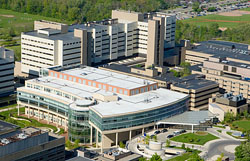
ZONE FOUR
The Medical Campus, including Kellogg Eye Institute, 300 North Ingalls Building and Turner Geriatric Center
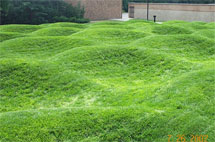 ZONE FIVE
ZONE FIVEThe areas around GG Brown, Media Union, Chrysler Center, Cooley Lab, North Campus Administrative Complex, Transportation Research Institute, Naval Architecture & Marine Engineering, Space Research, FXB, Pierpont Common, and Dow
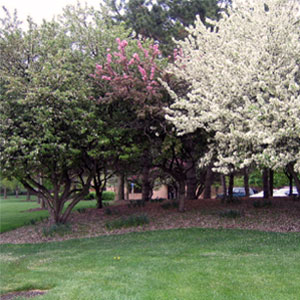 ZONE SIX
ZONE SIXBursley Hall, Ford Library, Vera Baits I & II, Bentley Library, Art & Architecture block, School of Music, and the Unversity Hospital Child Care Center
See more at University of Michigan Grounds Page
ORGANIZATION
GREEN GROUNDS
Fertilizer Usage and its Alternatives at the University of Michigan

WHY IS FERTILIZER HARMFUL?
fertilizer is often not absorbed, causing runoff
runoff leads to groundwater contamination that causes water to grow algal blooms which choke out the oxygen in water and degrade ecosystems
runoff forms toxic drinking water that causes adverse health effects for humans, specifically to the liver and kidneys
(Dopico 2012)
fertilizer is often not absorbed, causing runoff
runoff leads to groundwater contamination that causes water to grow algal blooms which choke out the oxygen in water and degrade ecosystems
runoff forms toxic drinking water that causes adverse health effects for humans, specifically to the liver and kidneys
(Dopico 2012)
GROUNDS
CURRENT ACTION
University Grounds Services is currently trying to reduce the use of chemical fertilizers and pesticides. They are also experimenting with the use of compost tea in the place of fertilizers and pesticides. As of now, all lawn fertilizers at the University of Michigan are phosphorus-free and are applied in accordance with the label.
RECOMMENDATIONS
We recommend that the University Grounds Services change their lawn care practices to eliminate the use of chemical fertilizers and to educate students, faculty, and the general public about fertilizers.
This can be accomplished through multiple tactics. For example, the University can make its lawns more attractive and sustainable through the use of native plants. Also, the University could survey students and staff to find out their opinions on using less or no fertilizer. Another tactic involves educating students and staff about fertilizer-free lawns and the ecological impacts that fertilizer has on our environment via signs, e-mails and events. Additionally, the continued and expanded upon use of eco-friendly fertilizers such as compost tea instead of chemicals will largely aid in this endeavor.
University Grounds Services is currently trying to reduce the use of chemical fertilizers and pesticides. They are also experimenting with the use of compost tea in the place of fertilizers and pesticides. As of now, all lawn fertilizers at the University of Michigan are phosphorus-free and are applied in accordance with the label.
RECOMMENDATIONS
We recommend that the University Grounds Services change their lawn care practices to eliminate the use of chemical fertilizers and to educate students, faculty, and the general public about fertilizers.
This can be accomplished through multiple tactics. For example, the University can make its lawns more attractive and sustainable through the use of native plants. Also, the University could survey students and staff to find out their opinions on using less or no fertilizer. Another tactic involves educating students and staff about fertilizer-free lawns and the ecological impacts that fertilizer has on our environment via signs, e-mails and events. Additionally, the continued and expanded upon use of eco-friendly fertilizers such as compost tea instead of chemicals will largely aid in this endeavor.
GREEN GROUNDS
References:
Dopico, E. Traditional and Modern Practices of Soil Fertilization: Effects On Cadmium Pollution of River Ecosystems in
Spain. Human Ecology, 37, 235-240. Retrieved February 15, 2012, from Abstracts in Anthropology (6123923).
Dopico, E. Traditional and Modern Practices of Soil Fertilization: Effects On Cadmium Pollution of River Ecosystems in
Spain. Human Ecology, 37, 235-240. Retrieved February 15, 2012, from Abstracts in Anthropology (6123923).